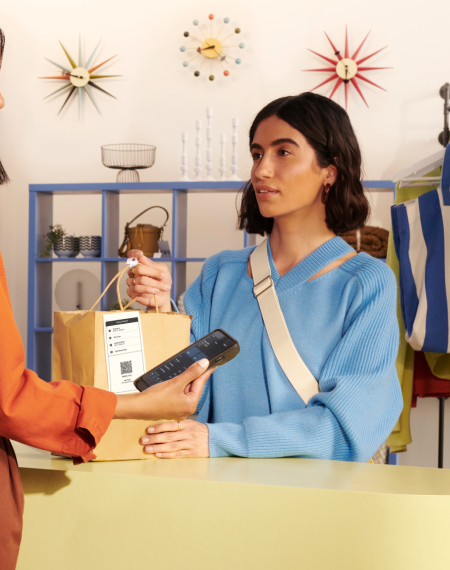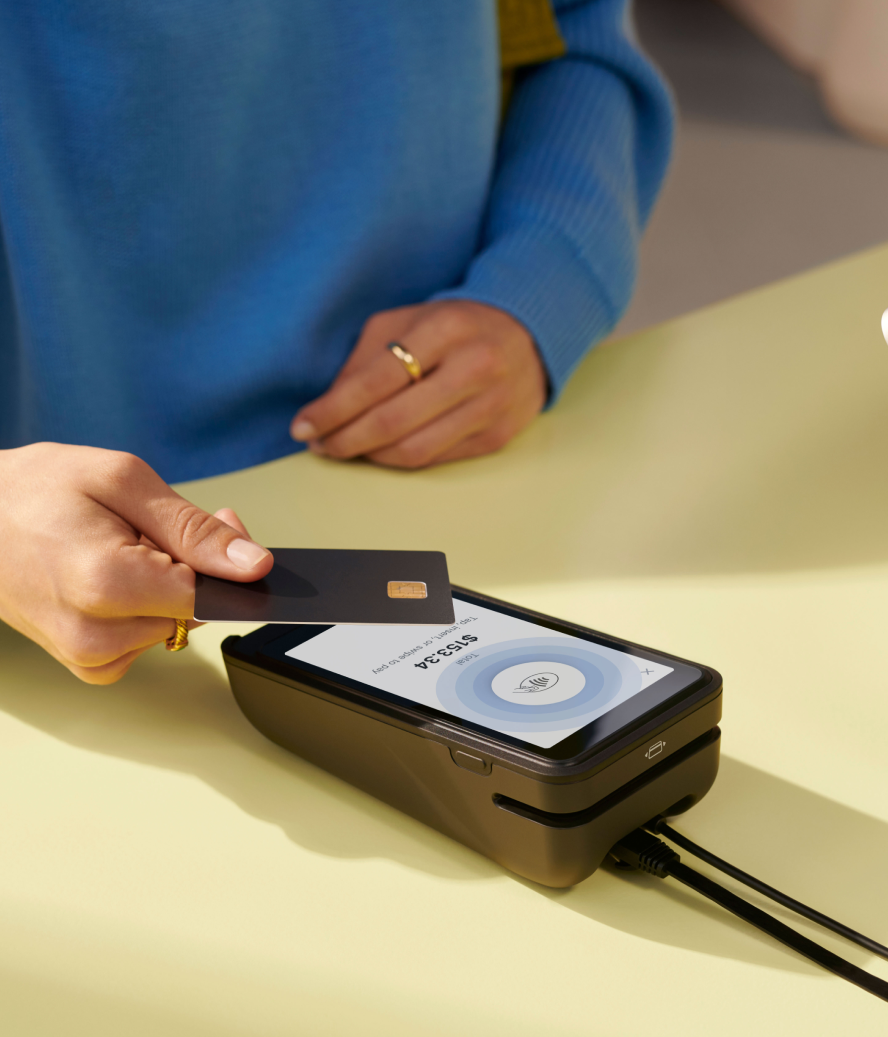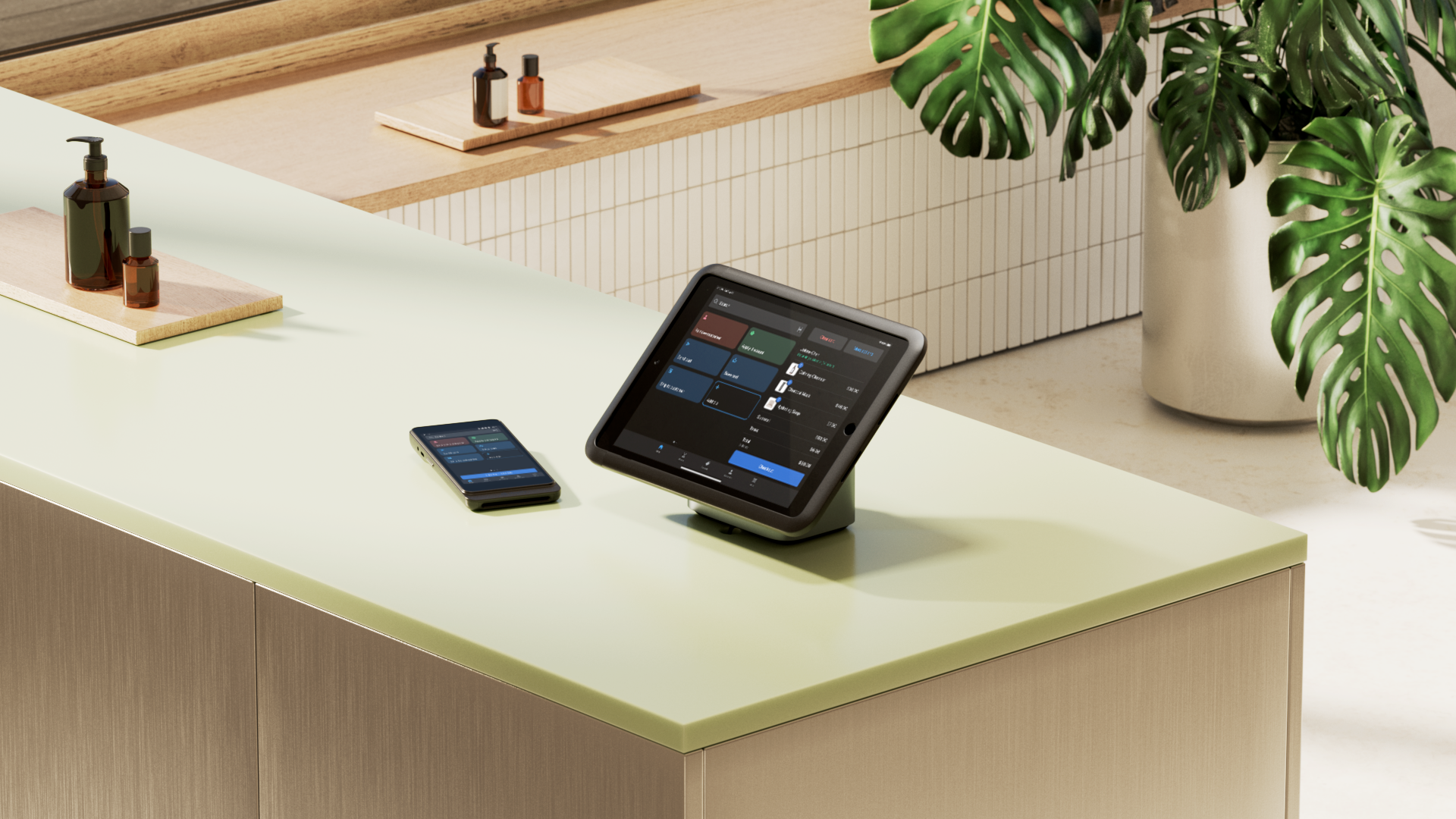A credit card reader is a device that lets you take payment in person by swiping the magnetic strip on a customer’s card. Credit card readers read the information stored on this strip to communicate with a payment network. The network then authorizes the transaction and transfers money from the customer’s bank account to yours.
If you plan to sell anywhere in person, it’s beneficial to take a card reader with you. Most modern consumers are cashless—about 60% of payments are made by card.
Credit card swipe transactions are more secure than cash, and their digital nature makes them easier to track. That’s a huge time saver when it comes to tax season and financial reporting.
So, how do you choose a card reader that allows you to process credit card swipes? This guide rounds up the best options, things to consider when shopping for yours, and how to navigate the complexities of credit card swipe fees.
Best credit card readers for small businesses
Shopify
Shopify has a line of credit card readers that integrate seamlessly with the Shopify point of sale (POS) system. You can open the Shopify POS app, connect your card reader to the device, and start taking credit card swipes from customers wherever you sell.
Popular options include:
- POS terminal: A countertop reader with a customizable customer-facing display. It connects via WiFi or Ethernet cable, so you can take card payments at the checkout desk.
- Tap to Pay: A tool that turns your iPhone into a mobile POS and card reader—no extra hardware required
Best features
- Syncs seamlessly with your online store, inventory, and customer data for a true unified commerce experience
- Accepts chip, tap, swipe, and mobile wallet payments, plus Tap to Pay on iPhone—no extra hardware needed
- Competitive rates start at 2.4% per transaction with no hidden fees, plus quick payouts to your bank or PayPal.
- Choose from mobile or countertop readers to match your selling environment, whether in-store or on the go.
Transaction fees
Payments made through a Shopify POS card reader will be processed through Shopify Payments. Rates for this payment gateway start at just 2.4% plus 10 cents per transaction, and there are no extra fees for customers who want to use Shop Pay Installments. You can process payouts to your bank or PayPal account within just a few days. Shopify POS also has a 22% better total cost of ownership (TCO) compared to alternatives, boosting ROI.
Square
Square is a POS system that offers credit card readers for businesses that want to accept payments in person. Its signature offering, the Square Terminal, is a small battery-powered device that accepts magstripe cards, contactless payments, and chip and pin transactions. It integrates with the Square POS system and apps that are compatible with desktops and smartphones.
Best features
- Accepts multiple payment types
- Integrates with Square POS and third-party platforms
- Fast setup
Transaction fees
Square has a set payment processing fee of 2.6% plus 10 cents per credit card transaction. If customers choose to pay in installments with Afterpay, this amounts to 6% plus 30 cents per transaction. Square promises next-day payout terms for qualifying transactions.
Clover
Clover is a POS system designed for small businesses. It offers multiple card readers, including Clover Flex, a battery-powered handheld device with built-in Wi-Fi and 4G connectivity built in. You can use it to process credit card payments from major banks like Visa, Mastercard, American Express, and Discover.
Best features
- Multiple hardware options
- Accepts multiple payment methods
- Customizable reports
Transaction fees
Clover fees start at 2.3% plus 10 cents per transaction. It takes a few days for your money to be paid out, but there’s an optional 1.5% fee to get your funds sooner.
Toast
Toast is a POS system specifically designed for restaurants. Its card readers and payment processing capabilities work online or offline, so you’re protected even during an internet outage.
Best features
- Works online and offline
- Table and menu management for restaurants
- Real-time fraud monitoring
Transaction fees
Toast’s payment fees aren’t very clear—rates are custom-built and personalized for every restaurant. For an accurate picture of costs, you’ll need to contact Toast’s sales team.
Zettle by PayPal
Formerly known as iZettle, PayPal acquired this POS system as a way for its merchants to get paid in person. It offers mobile card readers, a POS terminal, and a full POS checkout system.
Customers can swipe their card on a Zettle card reader and see the funds in their PayPal balance within minutes. Or, if you’re using Shopify’s ecommerce platform to operate an online store alongside in-person sales, you can use the Shopify integration to process payments in person with the Zettle mobile card reader.
Best features
- Fast transfer of funds to your PayPal account
- Accepts multiple payment methods
- Has several integrations
Transaction fees
Zettle has a fixed transaction fee of 1.75% for card and contactless payment paid via PayPal QR code. Payment links and invoices have a fee of 2.5%. These apply to all types of cards, including American Express (regarded as the most expensive for interchange fees).
Credit card swipe fees explained
Hardware
To accept credit card swipes, you need a physical card reader to process transactions securely. Credit card readers come in various forms, from countertop terminals with customer-facing displays to mobile readers that connect to smartphones or tablets. Some even offer Tap to Pay, so you don’t need additional hardware.
When choosing hardware, consider factors like connectivity (WiFi, Bluetooth, or Ethernet), compatibility with your POS system, and support for multiple payment types, including chip, tap, and swipe transactions.
Software
Credit card readers need software to communicate with banks, process transactions, and sync payment data with your business tools. The best POS systems include built-in payment processing software that integrates with inventory management, customer data, and online sales. Shopify is the only platform that does this for ecommerce and POS in a single place, providing a true unified commerce experience.
Some credit card readers require proprietary software, while others offer flexibility with third-party integrations. Look for software that ensures secure, PCI DSS-compliant transactions, provides real-time reporting, and allows for seamless payouts to your bank or digital wallet.
Payment processing fees
Banks charge businesses a credit card swipe fee whenever they accept this type of digital payment. It’s standard practice for the merchant to absorb this fee as a business expense so the customer doesn’t experience unexpected charges when they swipe their card.
These credit card swipe costs, also known as interchange fees, vary depending on the bank or card network. Some charge flat fees per transaction, while others take a percentage of the total amount that’s being processed. The latter is more common, and can range between 2% and 4%. Visa and Mastercard are considered to be the most affordable, whereas American Express tends to be on the higher end.
Types of credit card processing machines
There are different types of machines and terminals you can use to accept and process credit card payments in person:
- Mobile card readers: A mobile card reader is a portable device that allows you to accept credit card swipes anywhere. The devices usually have a screen and require an internet connection, such as WiFi or 5G, to process payments. Most mobile card readers allow you to accept various payment methods, including credit cards, mobile payments, contactless, and chip and pin.
- Handheld terminals: A handheld terminal works similarly to a mobile card reader in the sense that you can accept multiple payment methods and move the device around to process payments on the go. The main difference is that handheld terminals usually have a customer-facing screen. You can use this to display their order, show gift card balances, or give the option to add a tip.
- Countertop readers: A countertop reader is a fixed device tied to your checkout desk. It’s hardwired to your POS system through a USB cable (or an Ethernet connection) and doesn’t have a screen, hence it’s most commonly used in permanent brick-and-mortar stores.
- POS registers: A POS register is a fixed device that sits on your checkout desk. Instead of needing separate devices to ring up orders and process credit card swipes, a single POS register can handle both. It’s a good option for retailers with a brick-and-mortar store who don’t want the hassle of maintaining multiple devices.

Shopify merchant Derek Rose uses a combination of credit card processing machines, including Shopify POS and Shopify POS Terminal. Thanks to the technology, the retailer boosted in-store sales from using the POS from website stock by 5%—adding a significant 7% to turnover.
How to choose a card reader
Evaluate costs
How much does it cost to buy a card reader to accept credit card swipes? Startup companies might not have the cash to invest in a full-scale POS checkout, but mobile card readers have a lower barrier to entry due to their lower upfront cost.
Similarly, check that any flat-rate credit card swipe fees don’t absorb all of the profit from your lower-value transactions. If your chosen provider takes a percentage, confirm that you’d be willing to subtract this from your profits when customers choose this payment method at the checkout desk.
Consider mobility
If you plan to sell outside of a permanent location, consider how portable your card reader is. A mobile card reader allows you to sell anywhere, at any time—be that at a popup shop, a food truck, a farmer’s market, or a special event.
Even if you have a permanent store, mobile card readers bring the checkout process to the customer. This can reduce queues in stores even with a fixed countertop checkout, because you can take your card reader around the store rather than forcing customers to come to a fixed point of sale at your checkout desk.

Shortlist important features
Even if you don’t need a specific feature from your card reader right now, think ahead and anticipate what you might need in the future. Choosing a card reader that can scale as your business does will prevent you from having to repeat the setup process all over again.
Features to consider include:
- Whether it can take payments offline or through a phone connection
- Accepted payment methods, such as chip and pin, contactless, and mobile wallet payments (such as Apple Pay, Google Pay, and Samsung Pay)
- Average transaction speed
- How responsive the company’s customer support team is to resolve issues
Confirm integrations
Before you commit to a new card reader, check that it’s compatible with your existing tool stack, including your POS system, barcode scanners, receipt printers, and inventory management software. A seamless integration across all of these tools helps prevent inefficiencies and ensures that every transaction syncs smoothly with your business operations.
With Shopify, data from in-person and online sales automatically syncs to your Shopify admin—creating a truly unified commerce approach to retail. Whether a customer buys from your brick-and-mortar store, popup shop, or ecommerce website, their purchase history, payment details, and loyalty rewards stay connected in one place—eliminating data silos and fragmentation.
Confirm security
The Payment Card Industry Data Security Standard (PCI DSS) is a set of compliance standards that payment providers must adhere to to keep customers' data safe. Before investing in a new card reader, check that it is PCI DSS-compliant and offers security features like encryption and payment tokenization. This significantly reduces the risk of fraud or data leaks.
Accept credit card payments with Shopify POS
Although digital payment methods like contactless and mobile wallets are on the rise, some customers still prefer credit card swipes when they’re paying for goods in-store.
You’ll need a card reader to process those transactions—one that integrates with the POS software you’re already using, is PCI DSS-compliant and can scale with your business.
Shopify POS hardware is a no-brainer if you’re already using Shopify POS. The setup process is so simple that you could be up and running within the hour, and discounted payment processing fees leave more money in your pocket.
Best credit card swipe tech FAQ
What is a credit card swipe?
A credit card swipe is the act of sliding a card with a magnetic stripe through a card reader to process a payment. The reader captures the card’s data, which is then sent to the payment network for authorization. If approved, the transaction is completed, and the funds are transferred from the customer’s bank to the merchant.
What’s the difference between a POS and a card swipe machine?
POS systems do more than just process payments; they also manage inventory, sales reports, and customer info. A card swipe machine reads credit or debit cards to process payments and is usually part of a larger point-of-sale system.
Are there any card readers that don’t charge?
Most card readers charge a transaction fee for processing payments, but some providers offer free hardware when you sign up for their payment processing service.
What is the machine used for swiping credit cards?
A credit card reader or POS terminal is the device used to swipe credit cards and process payments. These machines can also accept chip and contactless payments, depending on the model. Some are standalone devices, while others connect to a POS system for more advanced business management features.
How much do credit cards make per swipe?
Credit card companies earn money through interchange fees, which merchants pay every time a customer swipes, taps, or inserts their card. These fees typically range from 1.5% to 3.5% per transaction, depending on the card network (Visa, Mastercard, American Express, or Discover) and the type of card used.
Can I use a credit card in a POS machine?
Yes, you can use a credit card in a POS machine. Modern POS systems are designed to accept credit and debit card payments. Depending on the device, you can process payments via swipe, chip, tap, or mobile wallets like Apple Pay and Google Pay. Many modern POS systems also integrate with online stores, allowing businesses to unify in-person and ecommerce transactions.





